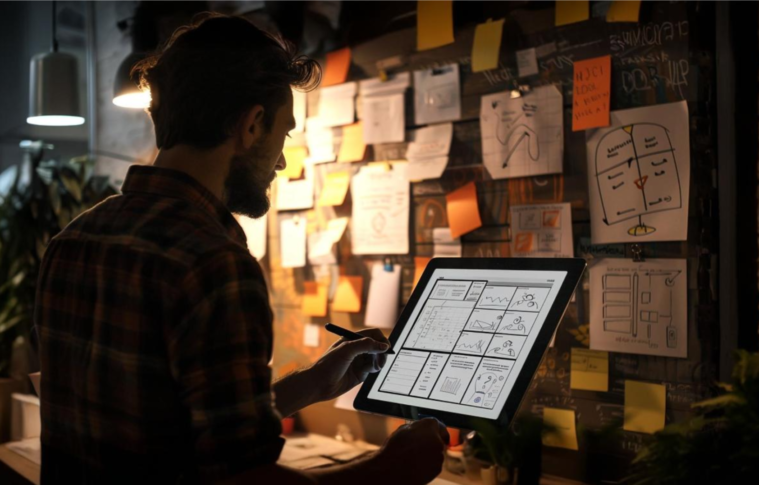Understanding the Difference Between Wireframes and Prototypes in UX Design
In the world of UX design, wireframes and prototypes are essential tools for building a user-centered product. Although these terms are often used interchangeably, they serve distinct purposes and occupy different stages in the design process. Knowing the difference can help you—and your team—move through design and development smoothly while maximizing time and resources.
Let’s explore the unique roles that wireframes and prototypes play, when to use each, and how they work together to bring ideas to life.
What is a Wireframe?
A wireframe is a basic, low-fidelity visual representation of a website, app, or other digital product. It lays out the skeletal framework of the interface, showing where key elements, such as headers, footers, images, and buttons, will be placed. Wireframes are typically devoid of colors, images, and styling details, focusing instead on structure and functionality.
Key Characteristics of Wireframes:
- Low-Fidelity: Wireframes are intentionally simple, often black and white, to keep the focus on layout and structure without distractions.
- Static and Non-Interactive: Wireframes lack interactivity, serving as a guide to what goes where rather than how it behaves.
- Focus on Layout and Information Hierarchy: By displaying key content areas and navigation, wireframes show the relationship between elements on the page.
- First Step in the Design Process: Wireframes are typically the initial step to ensure alignment on the basics of the design before moving into detailed aesthetics.
Benefits of Wireframes:
- Clarify the Structure: Wireframes provide a visual outline of how content and functionality will be arranged.
- Align Stakeholders Early: They offer a way to validate layout and flow before investing time in detailed design.
- Save Time and Resources: By focusing on the essentials, designers and stakeholders can make quick changes and iterate faster.
Example Use Cases for Wireframes:
- Outlining a page layout for an e-commerce product page
- Mapping out the main sections of a website homepage
- Defining the placement of navigation, search bars, and call-to-action (CTA) buttons
What is a Prototype?
A prototype is a high-fidelity, interactive representation of a digital product. Unlike a static wireframe, a prototype allows users to click through different screens, simulate navigation, and test interactions. Prototypes are used to demonstrate how a design will function and give a closer representation of the final product, often including elements such as colors, animations, and responsive behaviors.
Key Characteristics of Prototypes:
- High-Fidelity and Interactive: Prototypes are designed to look and feel like the finished product, including visual details and clickable elements.
- Demonstrate Functionality: They show how the product works, allowing users to experience flows and interactions.
- Enable Usability Testing: Prototypes allow for real-time testing of user interactions to gather feedback on functionality and ease of use.
- Further Along in the Design Process: Prototypes are usually created after wireframes have been approved, as they build on that structure with detail and interactivity.
Benefits of Prototypes:
- Simulate the Final Product: Prototypes provide a realistic experience, helping users and stakeholders understand the functionality.
- Test and Validate with Users: They allow for usability testing, which helps in refining the user experience based on real user feedback.
- Ensure Feasibility Before Development: Prototypes reveal potential design and development challenges early on.
Example Use Cases for Prototypes:
- Testing a checkout process flow on an e-commerce website
- Demonstrating how an onboarding sequence will work in a mobile app
- Showcasing the interactive elements of a new feature on a SaaS dashboard
Comparing Wireframes and Prototypes
| Aspect | Wireframe | Prototype |
| Fidelity | Low-fidelity, focusing on structure | High-fidelity, focusing on interaction and detail |
| Interactivity | Static, non-interactive | Interactive, simulating real user actions |
| Purpose | Defines layout, structure, and content hierarchy | Tests functionality, user flow, and usability |
| Stage in Design Process | Early stage, often the first step in design | Later stage, closer to development |
| User Testing | Not suitable for interaction-based testing | Ideal for usability testing and real-time feedback |
| Design Focus | Layout, placement of elements | Visual details, animations, and interactions |
How Wireframes and Prototypes Work Together
Wireframes and prototypes are part of a continuum in the design process. Here’s how they complement each other:
- Start with Wireframes: Begin with wireframes to establish a clear understanding of layout and information hierarchy. This allows all team members to align on the structural foundation before adding visual and functional details.
- Transition to Prototypes: Once the wireframe is approved, it can be transformed into a prototype by adding design elements, interactions, and clickable paths. This evolution allows users to engage with the design in a way that mimics the final product.
- Iterate Based on Feedback: Gather feedback at both stages. Wireframes can be reviewed to ensure structural clarity, while prototypes can be tested to evaluate functionality, usability, and user satisfaction. Use the insights gained to iterate and improve the design.
When to Use Wireframes vs. Prototypes
Use Wireframes When:
- You need to quickly outline and validate the layout and structure.
- You’re in the early phases of design and need stakeholder buy-in.
- You want to focus on content hierarchy without visual distractions.
Use Prototypes When:
- You’re ready to test specific interactions and navigation.
- You need to simulate the experience to gather user feedback.
- You’re closer to the development phase and need to refine functionality.
Final Thoughts: Building Better Experiences with Wireframes and Prototypes
Wireframes and prototypes each play a unique role in the design process, helping to bridge the gap between concepts and final products. By using wireframes to define structure and prototypes to test functionality, designers can deliver digital experiences that are well-thought-out, user-centered, and development-ready.
Understanding the difference between wireframes and prototypes—and knowing when to use each—empowers designers to create products that resonate with users and achieve business goals. The real magic happens when these tools work in harmony, creating a seamless process that transforms great ideas into fully realized, functional designs.



